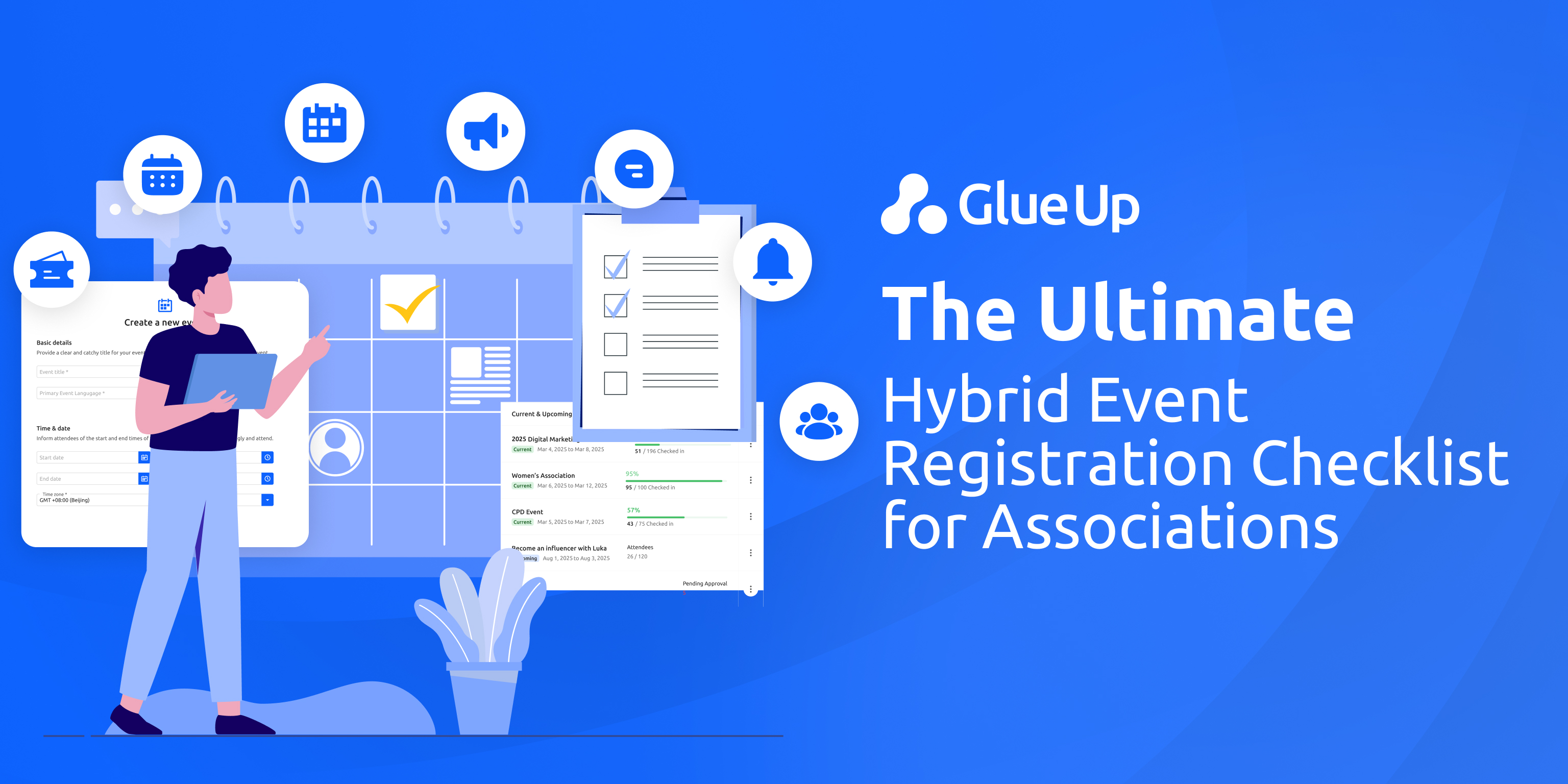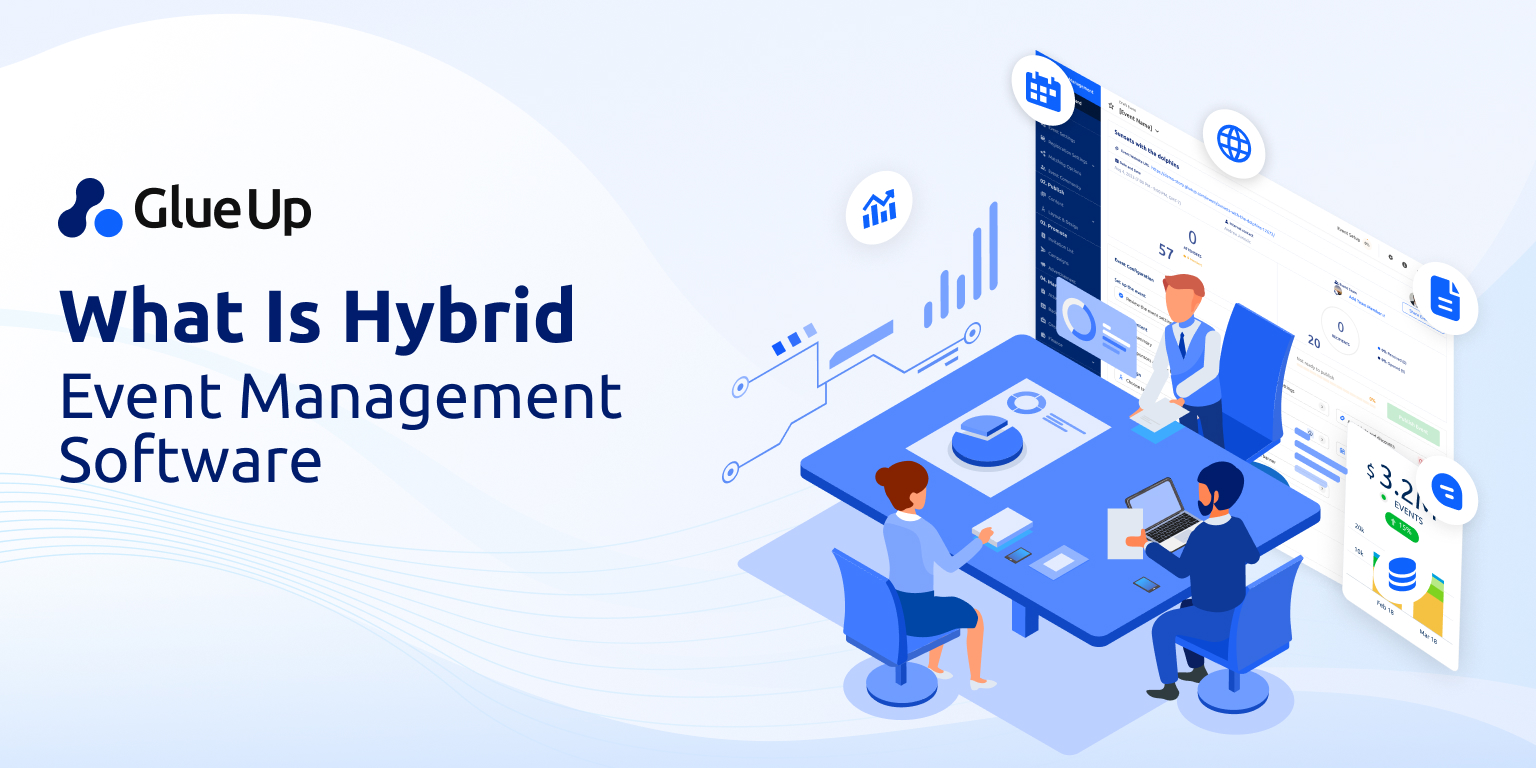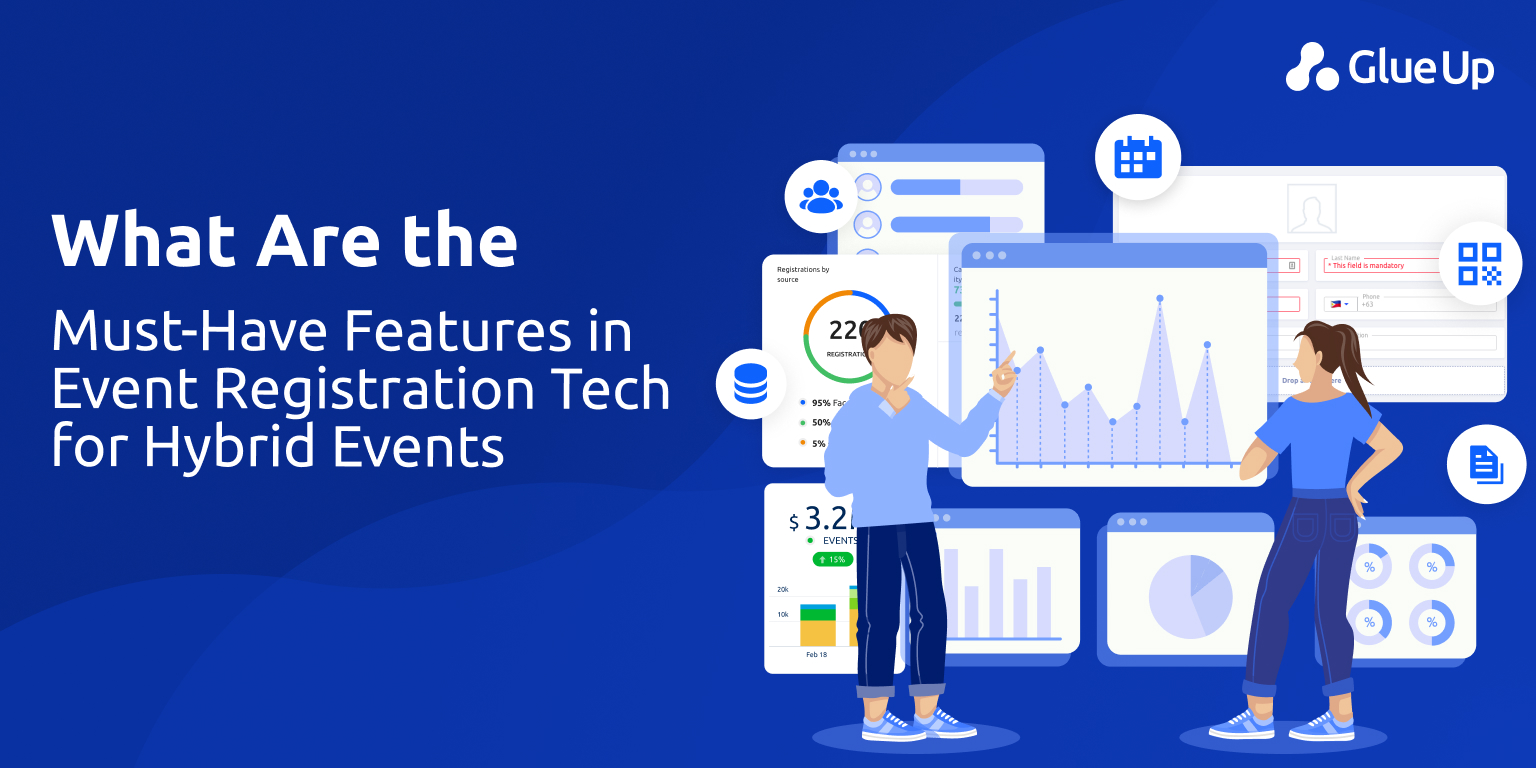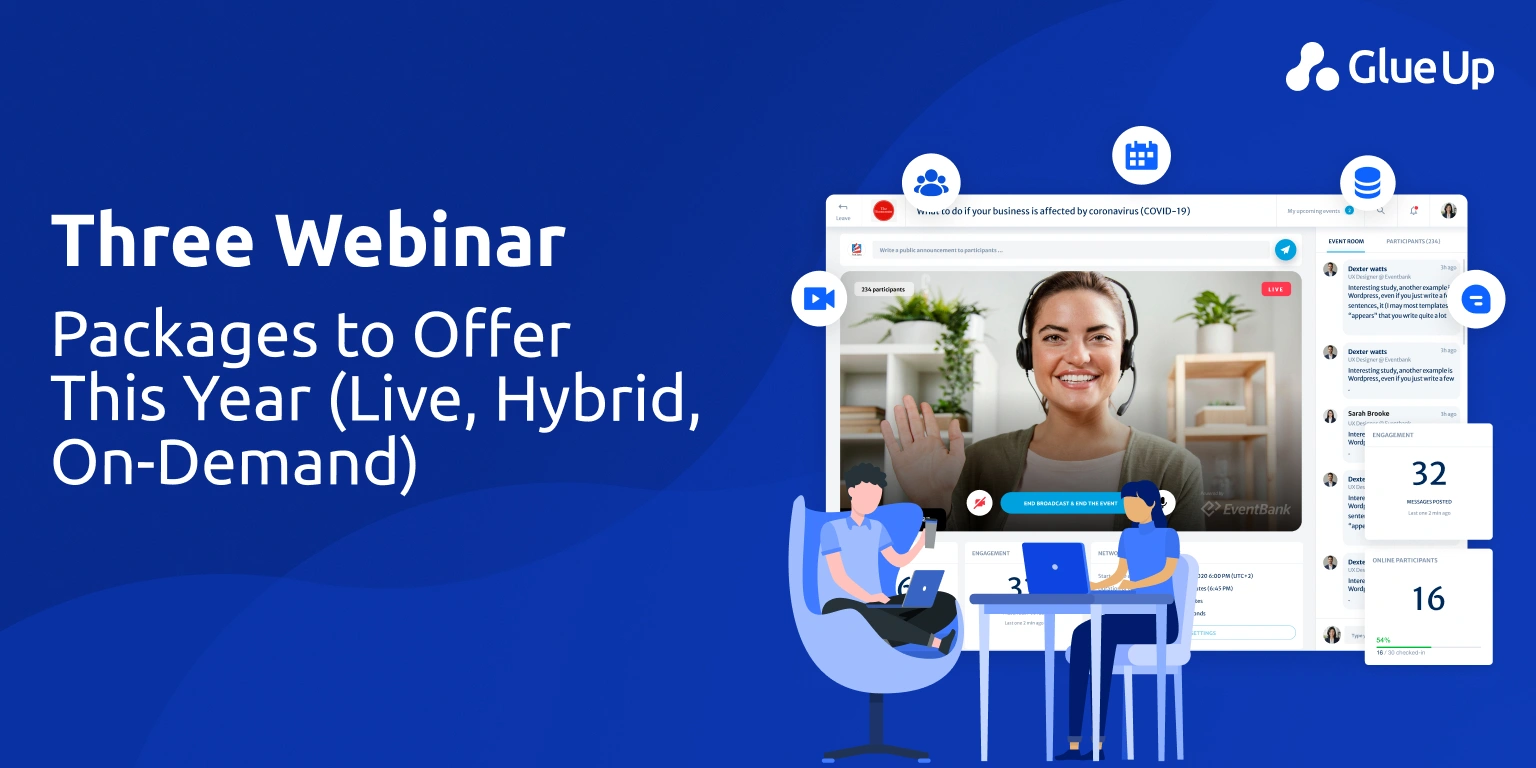
Imagine this: Susan, a chapter leader, is sitting on her couch late in the evening, registering for your association’s annual conference. She chooses the virtual pass, picks her breakout sessions, and hits “submit.” At the same time, Anthony, a corporate sponsor, walks into your ballroom brand activation area and submits registration for three in-person seats via his assistant’s desktop. Two very different journeys, yet they must show up in one system, one record, and one promise: no surprises, no hidden fees, no misalignment.
That’s the core of hybrid event registration. It’s not “add livestream to what we always do.” It’s designing a registration experience so that each person, virtual or in person, feels seen, informed, and confident. Nail that, and your event becomes smoother, your staff less stressed, and your membership happier.
In the next sections, I’ll walk you through a 12-week timeline, the form fields you actually need, payment and refund language you can stand by, integration with your membership system, confirmation and reminder flows, and how to measure success. And sprinkled through, you’ll see how Glue Up can make many of these parts simpler, cleaner, and more reliable.
Key Takeaways
Hybrid event registration is about creating one unified experience for two audiences: virtual and in-person, so both feel equally valued and informed.
Choose your hybrid model early (live + stream, replay-only, or separate virtual event). Every pricing, policy, and tech decision flows from that choice.
Follow a 12-week timeline for smoother operations: open early-bird registration, automate reminders, publish clear policies, and close with post-event follow-ups.
Keep registration forms short and smart, 5 to 8 essential fields, with conditional logic for accessibility, time zones, or sponsorship.
Publish refund policies clearly near the payment button. Transparency prevents disputes and builds trust.
Offer multiple payment methods (cards, ACH, invoices, digital wallets, split payments) to remove friction for attendees and sponsors.
Integrate registration with your membership CRM for one source of truth: member pricing, invoices, refunds, and attendance tracking in one place.
Automate confirmations and reminders by segment (in-person, virtual, sponsor). Include QR tickets, access links, and clear next steps.
Track core metrics like registration conversion, attendance rate, replay engagement, and refund volume to understand real ROI.
Provide an FAQ and publish it visibly to reduce confusion around refunds, access, and virtual participation.
Transparency and predictability build trust, when attendees know what they’re getting, registration numbers rise and stress drops.
Glue Up simplifies the entire process, uniting membership, events, finance, and communication into one connected experience.
Quick Reads
Choose Your Hybrid Shape Before You Price
Before you open registration, you must settle on which hybrid model you’re running. Because every decision downstream, ticket types, form logic, refund options, hangs on this. Broadly, there are three dominant models:
| Model | Ideal for | What virtual gets | Pricing implications |
|---|---|---|---|
| Live + synchronous stream | when you want real-time unity | live session feed, chat/Q&A, possibly polling | Virtual should cost less, but not too little |
| Live + delayed VOD / replay | when time zones or connection risk matter | full recordings unlocked after live window | Virtual may come later, but still part of registration |
| Virtual as separate event | when you’ll have distinct content online | curated sessions maybe different from live | Minimal overlap; separate marketing paths |
One thing you must do: publish clearly what virtual attendees will get (Q&A access, chat, recording window, networking options) from your registration page. That transparency prevents refund calls and bitterness.
Glue Up tip: In the Glue Up platform, each ticket SKU can be bound to particular benefit bundles, so virtual versus in-person perks, or add-on “recording access” SKUs, can map directly to what you promised.
Once you’ve committed to your shape, design your ticket grid as though you're writing a receipt: each column a ticket type, each row a benefit, check marks or “x” marks for features. Let readers see exactly what they’re paying for. That clarity increases trust, and conversions.
The 12-Week Registration Timeline That Works
Too many associations open registration early and then leave their registrants adrift. Others rush the process and suffer low take-up, last-minute chaos, and misunderstandings. The sweet spot is a structured, milestone-based timeline.
Here’s a reliable scaffold you can adapt (shifting earlier or later as your event size demands):
| Stage | What You Do | Primary Emails / Automations |
|---|---|---|
| T-12 to T-10 weeks | Publish pricing grid, open interest/waitlist form, enable UTM tracking, lock in venue | Interest to list, teaser “Coming Soon” |
| T-10 to T-8 | Open early-bird pricing; enable partner/chapter codes; send first registration invite | Early-bird launch, “member vs non-member benefit” |
| T-8 to T-6 | Drip content (speakers, previews, logistics); nudge folks who started but didn’t finish registration | Abandoned reg reminder, program tease |
| T-6 to T-4 | Open replay-only or virtual tickets, push accessibility info, publish code of conduct / policies | “Last chance” early-bird, policy reminder |
| T-4 to T-2 | Publish session catalog, allow ticket upgrades or swaps; drop “Add to Calendar” from confirmation screen | Upgrade pitch, session selector |
| T-14 days | Segment logistics emails (in-person, virtual), share check-in details, transport or streaming tips | Logistics email |
| T-7 / T-1 / morning-of | Send QR tickets, access links, app download, tech test reminders | Reminders by segment |
| T+1 to T+7 | Post-event emails: replay access, CE/PDH certificates, slides, survey, renew/upsell | Thank you + next step + follow up for no-shows |
The virtue of this timeline: each phase nudges behavior, closes open loops, and reduces surprise. Every email or automation has a role.
Glue Up tip: With Glue Up you can build Smart Lists (in-person registrants, virtual only, sponsors) and fire automated emails tied to those lists. QR code tickets, app push reminders, and session add-to-calendar logic live inside the system, so your team doesn’t hand off spreadsheets at the last minute.
The Form You Need: Minimal, Smart, Conditional
Registration forms are friction points. The longer they are, the more people bail. But you can’t omit essentials. The trick: capture the essentials first, and push conditional logic only when needed.
Core required fields (5–8):
First name / last name
Email (this is your unique identifier)
Organization / title
Ticket type (in-person, virtual, hybrid, add-ons)
Dietary / accessibility requests
Consent checkboxes (communication, photo/recording, code of conduct)
These six cover 90% of your registrants. Beyond that, use conditional logic:
If virtual: ask time zone, preferred format (live vs replay)
If in person: ask badge name / pronouns, emergency contact, onsite assistance needs
For sponsor or exhibitors: ask additional contact consent for follow-ups
You can also surface session track preferences (to power suggestions or marketing later)
UX tips:
Use a progress bar.
Autosave entered data if they leave and return.
Show pricing or tax breakdown next to the “Submit” or “Pay” button so there are no surprises.
Validate email domains if you need to auto-unlock member pricing (if you don’t use full SSO).
Glue Up tip: Because Glue Up ties registration to membership, your system can prefill fields for logged-in members, hide or show SKUs automatically, and avoid duplicate records. That means shorter forms and cleaner data.
Payment Options and Refund Policy Language with Backbone
You want zero pushback when someone asks, “I want a refund.” That means you design your payment options and your policy clearly and publish it boldly.
Payment Options
Offer as many credible payment modalities as practical:
Credit / debit cards
ACH / e-check
Invoice or purchase orders (especially for corporate or institutional payers)
Mobile wallets (Apple Pay, Google Pay)
Split payments (for high dollar tickets or bundles)
Show tax or service fees in the UI before final submit. Make sure the receipt has your EIN, line items (ticket, add-ons, tax), and cost center or GL code for your finance team.
Refund / Cancellation Policy (Sample Copy You Can Adopt)
Refund and Credit Policy
• 30+ days before event: full refund (less processing fees)
• 8–29 days prior: 50 % refund or full credit toward next event
• 0–7 days prior: no cash refund; attendee may convert to virtual/replay pass or receive full credit
• Name changes and ticket transfers allowed up to 7 days before event
• Replay-only purchases are nonrefundable once access is granted
Put that policy next to the Pay button and also in the confirmation page and email. That way no one can claim “I didn’t know.”
Because hybrid registration is more complex, allow conversions (in-person → virtual, upgrade, etc.) as a goodwill path rather than refund threats.
Glue Up tip: Glue Up supports refund workflows and credit handling out of the box. You can issue partial refunds, credit balances, or handle ticket swaps. Those are tied to each registration record, so your staff doesn’t wrestle with Excel problem cases.
Integration is Your Secret Weapon
If registration lives in a separate silo from membership, finance, and content, you’ll remake user profiles, send duplicate emails, and live with data chaos. The power of hybrid event registration lies in one system, one profile, one bill.
What must you integrate?
Member / contact record + status
Ticket SKU purchased
Add-ons and discounts
Payment / invoice / refund status
Consent flags (communication, sponsor outreach, recording permissions)
Attendance (check-in status for in person; virtual login / viewing stats)
CE / PDH / credits issuance
Segment tags (chapter, industry, role)
SSO (single sign-on) is key: when a member is already logged in, the system recognizes them, unlocks member pricing, and avoids duplicate account creation.
From a governance perspective, separate sponsor outreach permissions, map fields carefully, and apply deduplication logic.
Glue Up tip: In Glue Up, events and membership modules are built to talk. Registering fills or updates membership records. Ticket purchases, refunds, and attendance sync into your CRM so you never rekey. You can also auto-generate dashboards showing revenue by membership tier, chapter, or attendee type.
Confirmation and Reminder Emails That Anticipate Questions
Your confirmation email is more than a receipt. It’s your chance to set expectations, reduce confusion, and drive next steps.
What your confirmation email (and mirrored thank-you page) must include:
Event name, date(s), and time zone
QR code ticket for in-person or access link for virtual
Add-to-calendar buttons
Receipt/invoice link
Support contact (phone / email)
Top 3 next actions (e.g. “download app,” “review agenda,” “test your connection”)
Segment your reminder cadence:
T-7 days: essentials (logistics, arrival, livestream link)
T-1 day: final reminder, attire, access check
Morning of event: push link / QR, check-in instructions
For virtual: include tech test link, browser recommendations, backup connection path
After the event, send: thank you + replay / recording links + certificate (if applicable) + survey + renewal or upsell invite. For no-shows, send “We missed you, here's the replay” and offer incentives.
Glue Up tip: Use dynamic email templates inside Glue Up so each registrant sees only relevant content (in-person vs virtual). Automate the drip schedule and embed links or QR barcodes automatically pulled from each record.
Measure, Fix Leaks, and Optimize
Your event should teach you more than your attendees. Track these metrics:
Registration conversion rate (visits → registrations)
Cart abandonment rate (started but didn’t finish)
Attendance rate (registered → actually attended, by virtual and in person)
Replay uptake (who views after live)
Revenue per registrant
Member vs non-member mix
Channel attribution (email, partner, social, UTM)
Map your funnel, spot where people drop off (maybe at the form, payment, or checkout surprises). Fix those holes next time.
Board and leadership care about: total revenue, net revenue (after refunds), ROI per channel, membership growth impact, and engagement (session attendance, feedback).
Glue Up tip: Glue Up’s dashboard dashboards can show all these in real time. Run reports comparing cohort metrics (e.g. virtual attendees vs in-person) to guide your next registration cycle.
Frequently Asked questions (FAQ) You Should Surface
What’s included in the virtual ticket? (live access, Q&A, chat, replay window)
Can I switch from in-person to virtual? (yes, up to X days before, or pay difference)
What is your refund policy? (show your summary)
Will slides or recordings be available? (Yes, within X days)
Do I need special software or device? (supported browsers, mobile app, no installation)
What about time zones? (sessions scheduled or repeated, or on-demand)
How is attendee data handled / shared with sponsors? (consent flags, privacy)
Incorporate such an FAQ near the bottom of your registration page (collapsed + expandable) to reduce support tickets and cancellations.
How to Make Hybrid Registration Something People Like
People praise events when registration is transparent, easy, and predictable. If they feel baited, surprised, or confused, they’ll tell ten people.
Design your hybrid event registration as a user journey, not an admin chore. Choose your hybrid model early. Build a timeline. Cut your form to essentials. Publish refund policy boldly. Integrate your systems. Automate your emails. Measure obsessively.
If you give people clarity instead of friction, they’ll register sooner, complain less, and bring you more members.
Ready to see how this all looks in practice? Book a demo of Glue Up and see ticketing, check-in, refunds, membership sync, and dashboards working together, in one elegant flow.



